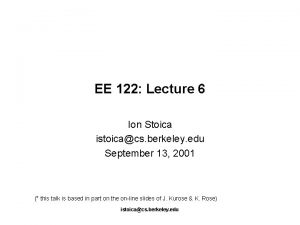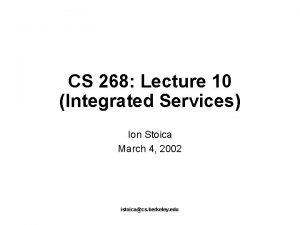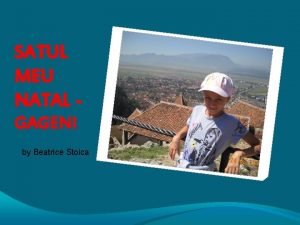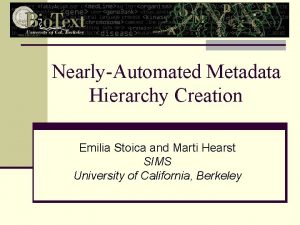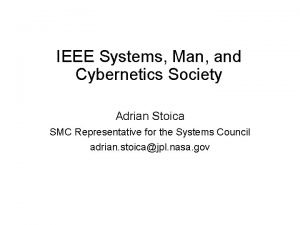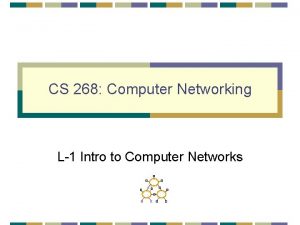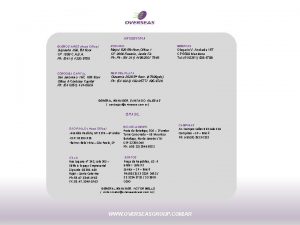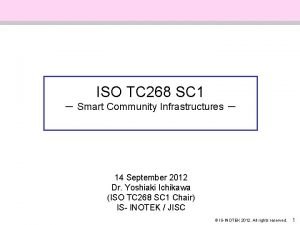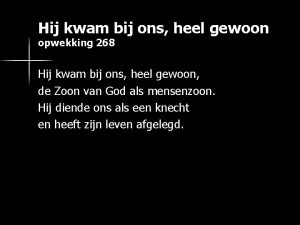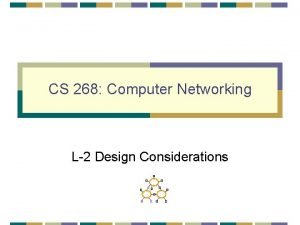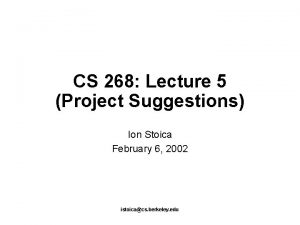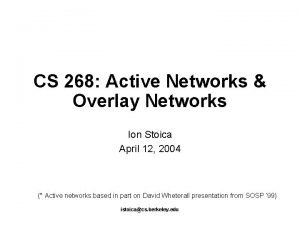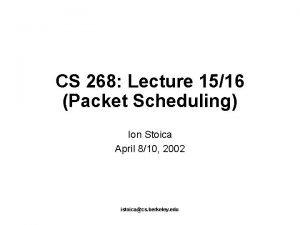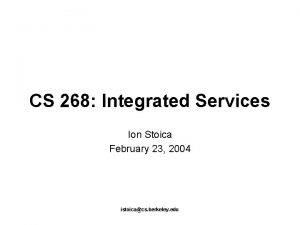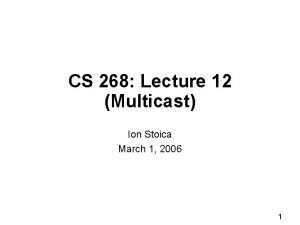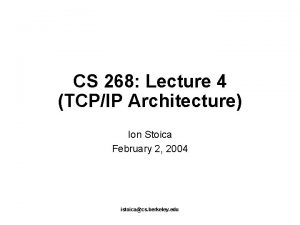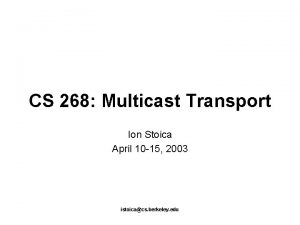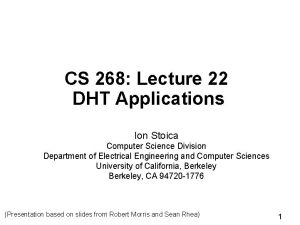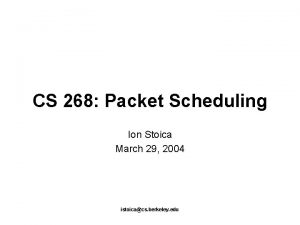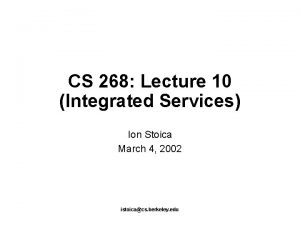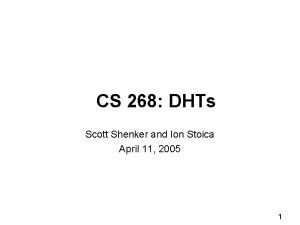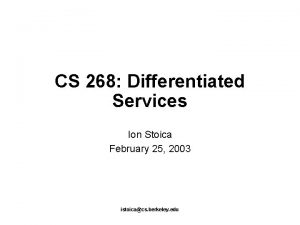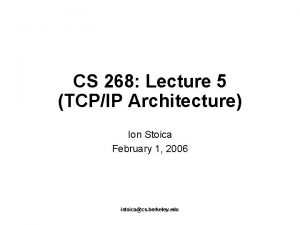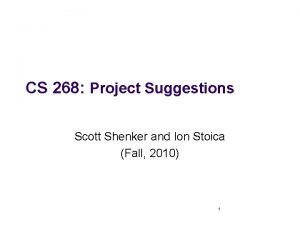CS 268 Project Suggestions Ion Stoica January 23









![i 3 vs. DOA S 2 S 1 ([id. S 1, id. R], data) i 3 vs. DOA S 2 S 1 ([id. S 1, id. R], data)](https://slidetodoc.com/presentation_image_h2/acf5f4401870b54dbe82515ec9fd4086/image-10.jpg)







- Slides: 17

CS 268: Project Suggestions Ion Stoica January 23, 2006

Overview § Will present >20 project suggestions § This lecture: class projects leveraging internal systems § Next lecture: other projects - Architecture - Theory - Systems 2

Background § Leverage and/or expand internal systems § Internet Indirection Infrastructure (i 3) § Overlay Convergence Architecture for Legacy Applications (OCALA) § Distributed debugging (Lib. Log) § Next, three short presentations on each of these projects (see associated files) 3

Project 1: IP Multicast Support in OCALA § Current implementation supports only IP unicast applications § Add IP multicast support - If overlay/network architecture implements multicast, OCALA should enable IP multicast applications to use it § Implement and evaluate IP multicast support on top of i 3 4

Project 2: Distributed Firewall § Today each company/user manages its/her own firewall - Hard to configure and maintain § Provide firewall functionality as a service - A user can have all her packets forwarded through the firewall irrespective of where/how is connected to the Internet - Firewall functionality distributed across a set of servers - Centrally managed § Possible implementation: - Use i 3 (or DOA) for indirection, and for implementing signaling protocol between firewall servers - Use OCALA to support legacy applications 5

Project 3: Signaling Protocol for Middleboxes § Design a signaling protocol to accommodate middleboxes/services § Research issues: - Authentication of middleboxes - Transparent recovery: when one middlebox fails another equivalent middlebox can take over - Challenge: recovery transparent to end-hosts at transport layer 6

Projects 4 -6: OCD Modules (Each Bullet One Project) 1) Packet-level compression § 2) Quality of Service § § § 3) Compress packet content / cache most common packets Both for outgoing and incoming (i. e. , TCP) connections Allow users allocate resources to each type of connection Use weighted round-robin (WRR) or Hierarchical-Fair Service Curve (H-FSC) as scheduler Allow a host behind a symmetric NAT or restrictive firewall behave as a host behind a cone-NAT that can be configured by the user § Application example: allow Bittorent clients behind NATs/Firewall run efficiently 7

Project 7: Composable OCD Architecture § OCD modules cannot be composed - One cannot take the input from one OCD module and feed it into another OCD module - E. g. , not possible to send i 3 traffic over HTTP or DNS without modifying i 3! § Design an OCD Architecture in which modules can be layered on top of each other § Challenges: - Come up with OCD descriptions and rules (language? ) that say which OCDs can be composed and how - Configuration, management, … 8

“ID-based” Architectures § § § Decouple the identity of an end-host/service from its address At transport level, sender sends packet to an ID, not an address Examples - Delegation Oriented Architecture (DOA) [http: //nms. lcs. mit. edu/doa/] - Host Identity Protocol (HIP) [http: //www. ietf. org/html. charters/hip-charter. html] - Internet Indirection Infrastructure (i 3) [http: //i 3. cs. berkeley. edu/] 9
![i 3 vs DOA S 2 S 1 id S 1 id R data i 3 vs. DOA S 2 S 1 ([id. S 1, id. R], data)](https://slidetodoc.com/presentation_image_h2/acf5f4401870b54dbe82515ec9fd4086/image-10.jpg)
i 3 vs. DOA S 2 S 1 ([id. S 1, id. R], data) i 3 ids 1 S 1 id. R [id. S 2, R] id. S 2 R Internet i 3 Name resolution infrastructure (e. g. , Open. DHT) id. S 1 S 1 S 2 S 1 DOA id. R R id. S 2 ([id. S 1, id. S 2], data) id. S 2 id. R Internet R id. S 2 id. R S 2 R 10

Projects 8 -9: i 3 Applications (One Bullet One Project) § File sharing application - Firewall/NAT support - Leverage anycast - Anonymity § Large scale multicast system using a centralized control plane - Multicast trees are computed at 11

Project 10: ID based Transport Protocols § § Design a congestion control mechanism (e. g. TCP) such that it is possible to change the receiving machine in the middle of the transfer Scenario: - A and B open a connection (A receiver; B source) - A changes to A’ - B continues to send data to A’ without creating a new connection § Research: refactor transport such that - Congestion control state binds to address - Data transfer state binds to ID 12

Project 11: Connection-based Middleboxaware Architecture § Existing middlebox-aware architectures such as i 3 and DOA present a network level interface - TCP/UDP connections are end-to-end § Cannot support middleboxes implementing application-level functionality: - E. g. , filtering on keywords in payload, caching, compression § Design an architecture that terminates TCP connections at middleboxes - Avoid breaking TCP semantics 13

Project 12: Event Notification System § Users specify events in which they are interested as a conjunction of attributes, e. g. , - (stock=“msr”) and (share_price > 60) - (source=“Berkeley”) and (destination=“North Lake Tahoe”) and (time < 3. 5 hours) § Research: create an efficient delivery tree - Users with the same interest grouped under the same tree - Users in the same geographic region grouped under the same tree 14

Project 13: Light-weigh Lib. Log § Logging and replay is not feasible in distributed systems with limited resources (e. g. , sensor nets, nanobots, etc. ) § Design a light-weigh approach to logging that is both power and space efficient § Research questions: - Is it necessary to log everything? - What events can be discarded without masking the bug from the programmer? 15

Project 14: Distributed Invariants § Goal: automatically figure out relevant invariants of the application so that programmers don't have to input them manually § Possible approach: adapt Daikon to discover distributed system invariants during replay. When such invariants are violated, alert the user - Daikon: a dynamic invariant detector) to the distributed case - See: http: //pag. csail. mit. edu/daikon/ 16

Project 15: Efficient Checkpointing § Build a checkpoint writing and transmission system based on LBFS (Low-bandwidth Network File System) to reduce communication and storage overhead - http: //www. fs. net/sfswww/lbfs/ § Integrate it with Lib. Log 17
 Ion stoica berkeley
Ion stoica berkeley Ion stoica
Ion stoica Beatrice stoica
Beatrice stoica Monica stoica
Monica stoica Emilia stoica
Emilia stoica Adrian stoica jpl
Adrian stoica jpl Emilia stoica
Emilia stoica C6h12 fuerza intermolecular
C6h12 fuerza intermolecular Dipolo dipolo inducido
Dipolo dipolo inducido Que son fuerzas intramoleculares
Que son fuerzas intramoleculares Intermolecular forces and vapor pressure
Intermolecular forces and vapor pressure Cs 268
Cs 268 Suipacha 268
Suipacha 268 268 rounded to the nearest hundred
268 rounded to the nearest hundred Iso tc268
Iso tc268 Hij kwam bij ons heel gewoon
Hij kwam bij ons heel gewoon Cs 268
Cs 268 Iso/tc 268
Iso/tc 268
